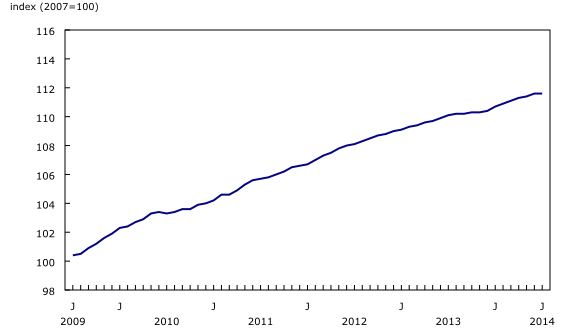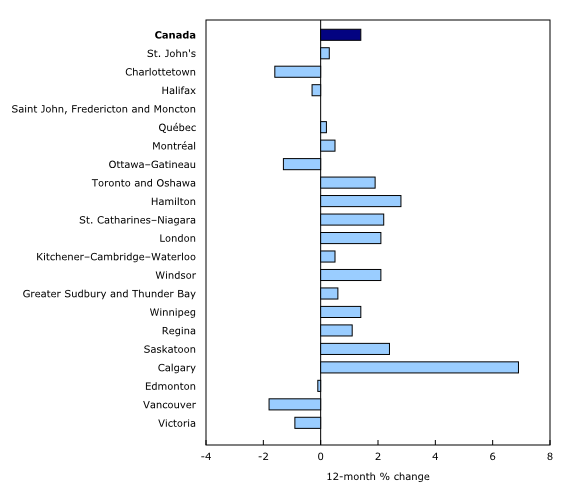New Housing Price Index, July 2014
Archived Content
Information identified as archived is provided for reference, research or recordkeeping purposes. It is not subject to the Government of Canada Web Standards and has not been altered or updated since it was archived. Please "contact us" to request a format other than those available.
Released: 2014-09-11
The New Housing Price Index (NHPI) was unchanged in July, following a 0.2% increase in June. Monthly price increases in eight metropolitan areas offset decreases in seven areas, resulting in no change to the Canada level index.
St. Catharines–Niagara and London (both up 0.3%) recorded the largest monthly price increases among the census metropolitan areas (CMAs) covered by the survey. Builders reported that market conditions contributed to the gain in both CMAs. This marked the third consecutive monthly price increase in London and the first since February in St. Catharines–Niagara.
New housing prices were up 0.2% in the CMAs of Hamilton, Kitchener–Cambridge–Waterloo and Calgary. In Hamilton—where prices have been rising since February—builders cited increased development charges and higher material costs as the reasons for the price rise. Builders reported that higher municipal levies were the main factor for the price increase in Kitchener–Cambridge–Waterloo, while builders in Calgary experienced higher material and labour costs as well as good market conditions.
Québec, Montréal and Regina saw new housing prices rise 0.1% in July.
Prices were unchanged in 6 of the 21 metropolitan areas surveyed.
New housing prices were down 0.2% in the CMAs of Ottawa–Gatineau and Vancouver. Builders in Ottawa–Gatineau reported lower negotiated selling prices in July, while builders in Vancouver offered bonus incentive packages and reduced list prices to stimulate sales. Monthly prices in Vancouver have been flat or decreasing for the past 12 months, while prices in Ottawa–Gatineau have been decreasing since March of this year.
Prices also declined in the combined metropolitan region of Toronto and Oshawa, as well as in Charlottetown, Halifax, Saskatoon and the combined region of Saint John, Fredericton and Moncton (all down 0.1%). This was the first decrease in Toronto and Oshawa since February 2010.
On a year-over-year basis, the NHPI rose 1.4% in July, the smallest annual increase since December 2013. Calgary (+6.9%) and the combined metropolitan region of Toronto and Oshawa (+1.9%) continued to lead the annual growth.
Other significant year-over-year increases occurred in Hamilton (+2.8%), Saskatoon (+2.4%) and St. Catharines–Niagara (+2.2%).
Among the 21 census metropolitan areas surveyed, 6 posted 12-month price declines in July: Vancouver (-1.8%), Charlottetown (-1.6%), Ottawa–Gatineau (-1.3%), Victoria (-0.9%), Halifax (-0.3%) and Edmonton (-0.1%). This was the first annual decrease in Halifax since early 1998.
Note to readers
The New Housing Price Index measures changes over time in the selling prices of new residential houses agreed upon between the contractor and the buyer at the time of the signing of the contract. It is designed to measure the changes in the selling prices of new houses where detailed specifications pertaining to each house remain the same between two consecutive periods.
The survey covers the following dwelling types: single dwellings, semi-detached houses and row houses (town houses or garden homes). The survey also collects contractors' estimates of the current value (evaluated at market price) of the land. These estimates are independently indexed to provide the published series for land. The residual (total selling price less land value), which mainly relates to the current cost of the structure, is also independently indexed and is presented as the estimated house series.
The prices collected from builders and included in the index are market selling prices less value added taxes, such as the Federal Goods and Services Tax or the Harmonized Sales Tax.
The index is not subject to revision and is not seasonally adjusted.
The New Housing Price Index for August will be released on October 9.
Contact information
For more information, or to enquire about the concepts, methods or data quality of this release, contact us (toll-free 1-800-263-1136; 514-283-8300; infostats@statcan.gc.ca) or Media Relations (613-951-4636; statcan.mediahotline-ligneinfomedias.statcan@canada.ca).
- Date modified:



